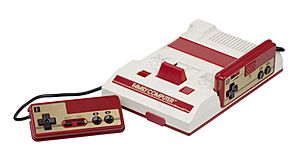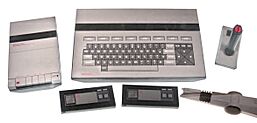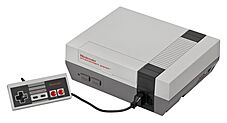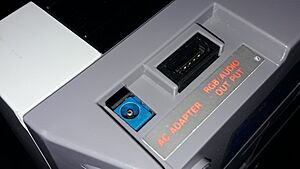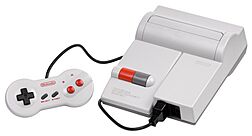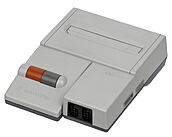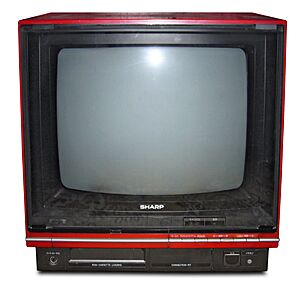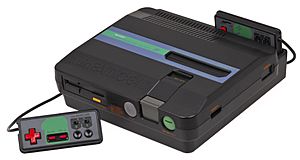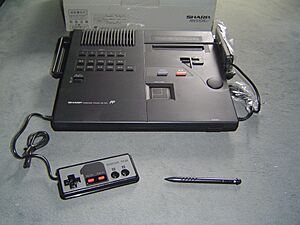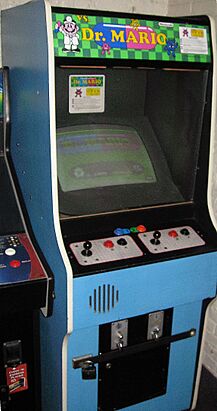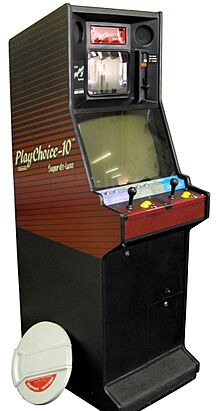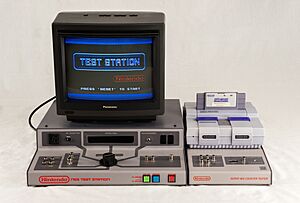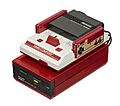Nintendo Entertainment System facts for kids
The Nintendo Entertainment System (NES) is a classic video game console made by Nintendo. It was first released in Japan in 1983 as the Family Computer , often called the Famicom . Masayuki Uemura led its design.
When Nintendo brought the console to North America in 1985, they changed its look and name to the NES. This was to avoid the bad reputation video games had after the Video game crash of 1983 that same year. The NES looked like a videocassette recorder (VCR) instead of a computer. Nintendo later sold the NES in Europe and other parts of the world.
Sharp Corporation, a company that worked with Nintendo before, made three official Famicom versions in Japan. These included a TV with a Famicom built-in, a console that combined the Famicom and Family Computer Disk System, and a console for making videos. Only the TV version was sold in North America. Nintendo also made two arcade versions: the Nintendo VS. System (1984) and the PlayChoice-10 (1986).
After the Super Nintendo Entertainment System (SNES) came out, Nintendo released a smaller, redesigned NES/Famicom in 1993. This new version had a top-loading slot for games, which was more reliable than the original front-loading one. This redesigned console was the only one still made when the NES was finally stopped in 2003.
Contents
Original Console Designs
The Famicom in Japan
When video games first appeared, Japanese toy stores didn't know what to do with them. They didn't sell TVs, which games needed. So, Masayuki Uemura designed the Famicom to look like a toy. This made it a cheaper option for families.
The Famicom was first planned with a metal case. But they changed it to strong plastic because the metal was too fragile. Nintendo's president, Hiroshi Yamauchi, chose the red, gold, and white colors. He was inspired by a scarf he liked and a TV antenna.
The Famicom's design also fit how Japanese people lived. Uemura made it flat so it could sit on the floor. He thought this would be more relaxing for players. The controllers were like the Game & Watch handheld games. This made it easy for people to learn, especially with the D-pad. The controllers had short cords. This kept players close to the console and TV, which was good for smaller Japanese homes.
The Nintendo Entertainment System in North America
Nintendo wanted to sell the Famicom around the world. They tried to work with Atari to sell it as the "Nintendo Enhanced Video System." But the deal fell apart because Atari had problems during the Video game crash of 1983.
Even with the crash, Nintendo's president, Yamauchi, still believed in selling the console in North America. He launched an arcade system called the Nintendo VS. System in 1984. This helped Nintendo see if people in the U.S. liked Famicom games. Its success encouraged Yamauchi to launch the console.
Lance Barr and Don James helped redesign the Famicom for North America. At first, it looked like a home computer and was called the Nintendo Advanced Video System (AVS). It had many extras like a keyboard, a musical keyboard, a tape drive, and infrared wireless controllers. It also had a folding light gun. The AVS was shown in January 1985 but didn't get much excitement. People were worried about the video game crash and the high price.
Nintendo then made a cheaper version of the AVS. This was shown in June 1985 and was called the Nintendo Entertainment System (NES). The new design, sometimes called the "lunch box," looked like a videocassette recorder. It had a front-loading slot for games. This design helped people see it as something different from older video game consoles.
Most of the AVS extras were removed, but the light gun stayed. It became the NES Zapper. To make sure people didn't see the NES as just another game console, Nintendo also introduced a toy robot called the Robotic Operating Buddy (R.O.B.). R.O.B. helped convince toy stores to sell the NES. The NES launched in New York City on October 18, 1985.
NES in Europe and Oceania
Nintendo also sold the NES in Europe and Oceania. It didn't do as well there as in North America. In Europe, it first came out in Scandinavia in late 1986. Nintendo worked with Mattel to sell it in the UK and Italy in 1987. Other countries like France and Belgium got it through another company.
Mattel's marketing wasn't very strong, especially with many home computers being sold. So, Nintendo changed distributors in the UK. Later, Nintendo took back all distribution rights. Eastern European countries got the NES much later.
In Oceania, Mattel sold the NES in Australia and New Zealand starting in mid-1987. It did better there than in Europe, but didn't become very popular until around 1993. Nintendo then started its own company, Nintendo Australia, and took over selling the console.
Europe was divided into two zones for games: PAL-A (UK and Italy) and PAL-B (rest of Europe). Games from one zone would not work on consoles from the other. French NES consoles were special. They had a different port that gave a clearer picture, but the console still used its original picture signal.
NES in Asia
The NES was also sold in other parts of Asia, outside of Japan. In South Korea, it was sold by Hyundai Electronics as the Hyundai Comboy in October 1989. Nintendo couldn't sell it directly because the Korean government had banned Japanese cultural products since World War II. This ban lasted until 2004.
In India, a version of the NES was sold as the Samurai Electronic TV Game System. But it was very expensive and didn't sell well. The "Samurai" name was later used for unofficial copies of the Famicom.
Redesigned Console Models
The New-Style NES was a smaller, cheaper version of the Famicom/NES. Nintendo released it in 1993. In Japan, it was called the New Famicom, or sometimes the AV Famicom (AV仕様ファミコン, Eibui Shiyō Famikon).
It was announced in North America on October 11 and released later that month for about US$50. It was sold in Japan starting December 1 for ¥6,800. This redesigned console was not released in Europe.
Lance Barr redesigned the New-Style NES. It had a vertical slot for game cartridges. This fixed problems with the original NES's spring-loaded front-loading slot. The new console also removed the 10NES lockout chip, which meant it could play unofficial games.
The New-Style NES only had RF output for connecting to a TV. Nintendo later made a rare version with the AV "multi-out" port, like the SNES. The new NES didn't come with a game. But it had a new controller shaped like the SNES controller. People called it the "dog bone" controller because of its shape.
The New Famicom looked similar to the New-Style NES. But it didn't have the "bump" on the cartridge slot. This was to fit the shorter Famicom cartridges. It came with two "dog bone" controllers. This made it easy to replace broken controllers. However, games that used the microphone on the original Famicom's second controller did not work with the New Famicom.
The New Famicom had composite video output, which was better than the original Famicom's RF-only output. But it didn't come with an AV cable or power adapter. Nintendo thought people would already have a Super Famicom and could use those cables.
An earlier prototype, called the Famicom Adapter, was shown in 1988. It would have let the Super Famicom play Famicom games. But it was never made. The New Famicom took its place.
The New-Style NES stopped being made in August 1995. The New Famicom stopped in September 2003. This was because parts became hard to find. This marked the official end of all Famicom/NES production. The last Famicom console was kept by Nintendo. It was shown at a game exhibition in Japan to celebrate the console's 20th anniversary.
Sharp-Made Console Versions
Sharp Nintendo Television
The Sharp Nintendo Television, also known as the C1 NES TV, was a TV with a Famicom/NES built right in. Sharp made it with Nintendo's permission. It first came out in Japan in October 1983 as the My Computer TV; . It was also sold in Taiwan.
The C1 TV was shown in the U.S. in 1987 but wasn't released until 1989 as the Game Television. This TV was special because it gave a very clear picture. This is why many video game magazines used it to take screenshots of games.
In Japan, the TV came in two sizes: 14-inch and 19-inch. It also came in black and red, or silver and red. In the U.S., only a black 19-inch model was sold for about $799.
Japanese versions of the C1 had two built-in programs: JR GRAPHIC and TV NOTE. They also came with a special game cartridge. This cartridge had trial versions of Donkey Kong Jr. and Donkey Kong Jr. no Sansuu Asobi. The Japanese systems also had controllers that could be removed.
Sharp later made a similar TV in Japan with the Super Famicom built-in, called the SF1.
Twin Famicom
The Twin Famicom was a home video game console made by Sharp. It was only released in Japan on July 1, 1986, for ¥32,000. The Twin Famicom was a Nintendo-approved product that combined the Famicom and the Family Computer Disk System into one machine.
The regular Famicom only had one color. But the Twin Famicom first came in two colors: red with black, and black with red. A second version came out in 1987 with a slightly different look. It had "turbo" controllers and new colors: black with green, and red with beige.
The Twin Famicom had slots for both Famicom cartridges and Disk System floppy disks. A switch let you choose between them. It also had power, reset, and eject buttons. The back of the console had spots to store the controllers.
Like other Famicom versions, the Twin Famicom had an expansion port for extra devices. It also had three other expansion ports, but no known devices ever used them.
The Twin Famicom gave a clearer picture and sound than the original Famicom. It used RCA connectors for video and audio. These connections were rare in Japan at the time. It came with an external RF modulator to connect to older TVs. Like the original Famicom, its two gamepads were built into the console.
Famicom Titler
The Famicom Titler, also known as the Famicom Editor, was a Famicom-based home video game console made by Sharp Corporation in 1989. It was only sold in Japan for ¥43,000. Sharp made this console because it was hard to record video directly from a Famicom game.
The Famicom Titler was the only Famicom console sold to the public that could create RGB video. This gave a much clearer picture than other Famicom models. It was also the only Famicom with S-Video output, though it also had composite video. The system had a keyboard and a touch-sensitive pad. This let users add subtitles to games or do other basic video editing. It also had a microphone for adding voice-overs.
Even though it was not well-known when it first came out, the Famicom Titler has become popular with collectors and people who modify consoles. They like it for its clear picture quality, which is similar to the arcade Nintendo VS. System and PlayChoice-10 systems. It's also easy to modify to get a true RGB signal for modern TVs.
Arcade Versions
Nintendo VS. System
The Nintendo VS. System was an arcade system made by Nintendo. It came out in March 1984 in the U.S., Europe, and Japan with the game Vs. Tennis. It was based on Famicom hardware. Nintendo used it to show Famicom games to people in the United States. This was important because stores were worried about selling home consoles after the Video game crash of 1983.
Two main versions of the VS. System cabinets were made. Both had two screens. One was an upright cabinet, and the other was a sit-down cabinet, often called the "red tent." These cabinets used two motherboards and could support up to four players. Later, Nintendo made a smaller, more traditional upright cabinet called the VS. UniSystem in 1985. It used only one motherboard but still had two sets of controls for two players.
The VS. System hardware was much like the Famicom's. But it had more memory. This allowed games to have more levels and features than their home console versions. To change games, operators would swap out a chip. All cabinets could offer two different games, one for each screen. Or they could have one game that supported multiplayer across both screens.
The two-motherboard cabinets cost about $2,400. The UniSystem cabinet was under $2,000. Each game cost less than $300. Nintendo also sold kits to change older arcade cabinets into VS. System ones.
Even though some people thought the VS. System's graphics weren't as good as other arcade games, Nintendo had great success with it in the U.S. They sold over 10,000 units in 1984 alone. Over 40 games were released before it was stopped in 1990. However, it wasn't as successful in Japan. Nintendo stopped making arcade systems in Japan in late 1985.
PlayChoice-10
The PlayChoice-10 was another arcade system made by Nintendo. It came out in August 1986. It was designed to show off NES games and still make money from arcades. Players could try up to ten different NES games, one at a time.
There were two upright cabinet versions: one with two screens stacked, and one with a single screen. A smaller "cabaret" version with a 9-inch screen above a 15-inch screen was sold outside the U.S. Nintendo also offered kits to change other arcade cabinets into PlayChoice-10 machines. There was even a countertop version called the PlayChoice CounterTop System.
Gameplay was limited by time. Players got at least two minutes. Putting in more coins added more time. Players could switch between games easily by pressing a button to bring up a menu. They could also pause and reset the game. On two-screen cabinets, the top screen showed the game menu and instructions, while the bottom screen showed the game itself.
The games on PlayChoice-10 were slightly different from their home console versions. All of them included game instructions. Some games, like Punch-Out!!, saved high scores.
There were 53 games released for the PlayChoice-10. Nintendo announced on July 31, 1992, that it would stop making all its arcade machines because they were no longer profitable.
Diagnostic Console
The Nintendo Test Station was a special device made by Nintendo. It was used in repair centers to check NES accessories. It could find problems with video cables, power supplies, and game controllers. A version for the Super NES was also made.
Related pages
Images for kids
-
The Famicom game console at the Computer and Video Game Console Museum of Helsinki in 2012
-
The Japanese Famicom has BASIC support with the Family BASIC keyboard.
-
The Disk System peripheral for the Japanese Famicom uses games on "Disk Cards" with a 3" Quick Disk mechanism.
-
The RetroUSB AVS, an FPGA-based hardware clone of the NES that outputs 720p via HDMI
See also
 In Spanish: Nintendo Entertainment System para niños
In Spanish: Nintendo Entertainment System para niños


